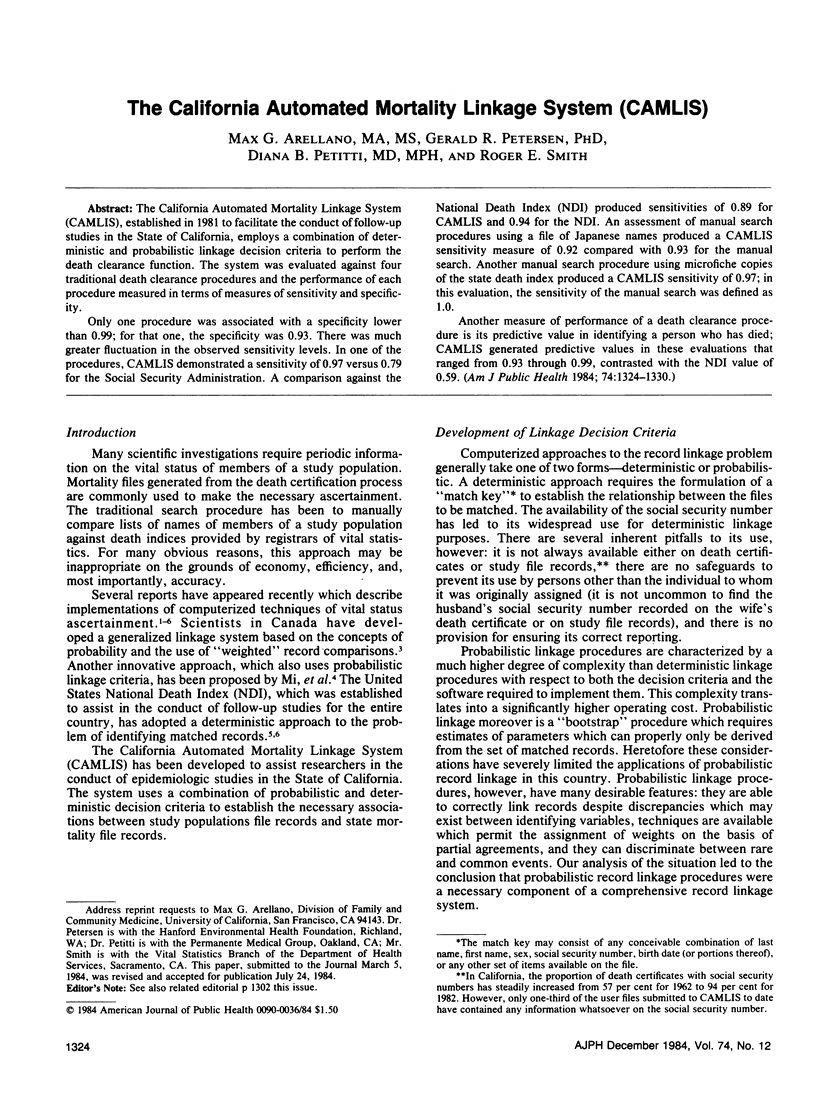Abstract
The California Automated Mortality Linkage System (CAMLIS), established in 1981 to facilitate the conduct of follow-up studies in the State of California, employs a combination of deterministic and probabilistic linkage decision criteria to perform the death clearance function. The system was evaluated against four traditional death clearance procedures and the performance of each procedure measured in terms of measures of sensitivity and specificity. Only one procedure was associated with a specificity lower than 0.99; for that one, the specificity was 0.93. There was much greater fluctuation in the observed sensitivity levels. In one of the procedures, CAMLIS demonstrated a sensitivity of 0.97 versus 0.79 for the Social Security Administration. A comparison against the National Death Index (NDI) produced sensitivities of 0.89 for CAMLIS and 0.94 for the NDI. An assessment of manual search procedures using a file of Japanese names produced a CAMLIS sensitivity measure of 0.92 compared with 0.93 for the manual search. Another manual search procedure using microfiche copies of the state death index produced a CAMLIS sensitivity of 0.97; in this evaluation, the sensitivity of the manual search was defined as 1.0. Another measure of performance of a death clearance procedure is its predictive value in identifying a person who has died; CAMLIS generated predictive values in these evaluations that ranged from 0.93 through 0.99, contrasted with the NDI value of 0.59.
Full text
PDF






Selected References
These references are in PubMed. This may not be the complete list of references from this article.
- Beebe G. W. Record linkage systems--Canada vs the United States. Am J Public Health. 1980 Dec;70(12):1246–1248. doi: 10.2105/ajph.70.12.1246. [DOI] [PMC free article] [PubMed] [Google Scholar]
- Howe G. R., Lindsay J. A generalized iterative record linkage computer system for use in medical follow-up studies. Comput Biomed Res. 1981 Aug;14(4):327–340. doi: 10.1016/0010-4809(81)90004-5. [DOI] [PubMed] [Google Scholar]
- Mi M. P., Kagawa J. T., Earle M. E. An operational approach to record linkage. Methods Inf Med. 1983 Apr;22(2):77–82. [PubMed] [Google Scholar]
- NEWCOMBE H. B., KENNEDY J. M., AXFORD S. J., JAMES A. P. Automatic linkage of vital records. Science. 1959 Oct 16;130(3381):954–959. doi: 10.1126/science.130.3381.954. [DOI] [PubMed] [Google Scholar]
- Newcombe H. B. Record linking: the design of efficient systems for linking records into individual and family histories. Am J Hum Genet. 1967 May;19(3 Pt 1):335–359. [PMC free article] [PubMed] [Google Scholar]
- Rogot E., Feinleib M., Ockay K. A., Schwartz S. H., Bilgrad R., Patterson J. E. On the feasibility of linking census samples to the National Death Index for epidemiologic studies: a progress report. Am J Public Health. 1983 Nov;73(11):1265–1269. doi: 10.2105/ajph.73.11.1265. [DOI] [PMC free article] [PubMed] [Google Scholar]
- Smith M. E., Newcombe H. B. Accuracies of computer versus manual linkages of routine health records. Methods Inf Med. 1979 Apr;18(2):89–97. [PubMed] [Google Scholar]
- Wentworth D. N., Neaton J. D., Rasmussen W. L. An evaluation of the Social Security Administration master beneficiary record file and the National Death Index in the ascertainment of vital status. Am J Public Health. 1983 Nov;73(11):1270–1274. doi: 10.2105/ajph.73.11.1270. [DOI] [PMC free article] [PubMed] [Google Scholar]


